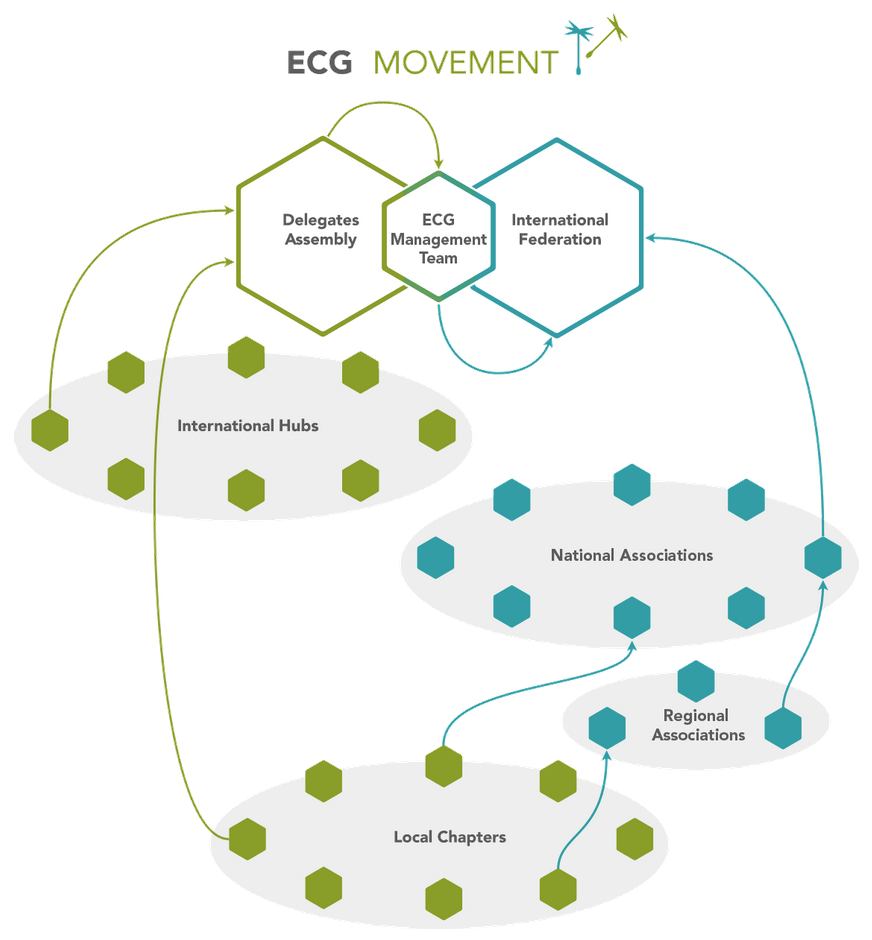Movement Structure
The structure of our organisation is based upon one our main values such as transparency and co-determination. It is composed of like-minded individuals, groups and organisations that relate to each other in different ways and contribute their unique skills towards a common goal.
- Delegates Assembly: The movement’s international decision-making body comprising of representatives across all Local Chapters and Hubs.
- ECG Management Team (EMT): The management team is composed of representatives of the legal and operational parts of the organisation.
- International Federation (IF): The IF is the umbrella organisation of the ECG. ECG national associations are members of the IF.
- Federation Members Council (FMC): The FMC consists of representatives of the ECG national associations. It manages and decides, among others, on the legal issues.
- Hubs: Hubs are permanent groups dedicated to specific topics such as consulting, auditing, communication, education and public speaking.
Local Chapters: Local Chapters form the backbone of our movement. Activists work to help implement ECG through organizing local events, contacting businesses and creating networks.
- ECG Companies: Companies that have completed their Common Good Balance Sheet, Audit and/or peer-evaluation.
- ECG Advocates: Well-known experts and entrepreneurs who support the model and initiative of ECG and speak to the general public and media on behalf of the movement.
- Partner organisations: Private and public institutions with similar vision that collaborate in numerous initiatives on issues around new economy, global justice, climate justice and more.
On the left side (green) there are Local Chapters and Hubs, which are represented by the yearly Delegates Assembly. On the right side (blue) you can see the legal entities like the regional and national associations, or the International Federation (IF). Operational tasks are taken over by the ECG Management Team (EMT).
Apply ECG
Get Involved
As a global non-profit, ECG has an amazing potential to transform our economic system, but all of our funding relies on people like you. Can you give today to keep the ECG strong? Donate here or become a member here.
You can participate:
- As an Individual
- As a Company or Organisation
- As a Municipality
- As an Educational Institution
Model and Tools
a) Basics and examples
- Matrix: Model for the organisational development and evaluation of entrepreneurial as well as charitable activities. It assesses and scores the contribution to the common good by evaluating 20 themes in the intersection between values and stakeholder groups.
- Good Practices: Brochure with real-life examples for every Matrix Common Good theme.
- Businesses act for the Common Good and the SDGs
b) Macroeconomy
- Common Good Product: Economic instrument that measures the achievement of core values of a society and progress made towards economic goals derived from these values.
- Common Good Index
- Codetermination, transparency and sociocracy
c) Microeconomy
- Balance Sheet: Complementary tool to the traditional financial balance, through which the contribution that each organization makes towards the Common Good is evaluated and qualified, facilitating a systematic examination of all activities from a 360° perspective.
- Audit and Peer evaluation: There are two ways of completing your Common Good Balance Sheet.
- If a company works together with other companies in a peer group to produce its report, this is regarded as a peer evaluation.
- In all other cases, the report is evaluated by an external audit.
- Report
- Calculator
- Fokus
- Ecogood Business Canvas: Tool that combines the ECG model with the advantages of the well-known business canvas to allow companies and organisations to anchor their purpose and contribution to socio-ecological change in their business model right from the start, or to transform it.
